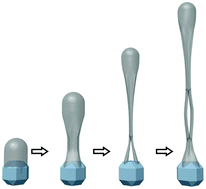When a river comes up against an obstacle, it will split and flow around it before joining up again, thereby forming a central island. Similarly, carbon nanotubes can be grown to split apart and then re-join through the judicious use of metal catalysts. The authors of this communication, Hasegawa and Kohno, identified this phenomenon and coined the term ‘origami mechanism’ to describe it.
My river analogy is, however, a rather simplistic take on what they found. In order to draw a more accurate comparison I must turn to tree limbs. Imagine a branch with a linear split; there will be a hole in the middle, flanked by bare timber, and the bark will be effectively split into two halves with clearly defined edges. This would be equivalent to the carbon nanotube splitting into two ribbons with terminal edges, before reforming into an entire nanotube, as one might expect to observe.
However, this does not entirely tally with what Hasegawa and Kohno actually found. Their findings align more closely with the example of a wisteria, which has co-dominant stems, which grow apart and then re-fuse as the plant twists around itself as it grows. The difference here is that each of the stems, whilst apart, still retains a full covering of bark, as it is a distinct branch. Indeed, the authors found that the nanoribbons take the form of entire flattened nanotubes before they join up again.
Of course, the reality is more complex still, and you can’t beat reading about it in the authors’ own words, which incidentally, I strongly encourage you to do.
Splitting and joining in carbon nanotube/nanoribbon/nanotetrahedron growth
Takayuki Hasegawa and Hideo Kohno
Phys. Chem. Chem. Phys., 2015, DOI: 10.1039/C4CP05139D











